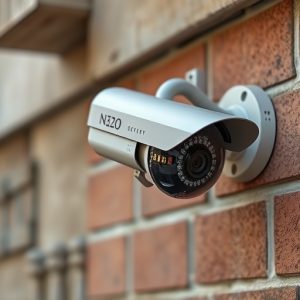Fake CCTV Cameras With Motion: A Study’s Methodology and Deterrent Effectiveness
A rigorous experiment was conducted to assess the effectiveness of Fake CCTV Cameras With Motion as…….
A rigorous experiment was conducted to assess the effectiveness of Fake CCTV Cameras With Motion as crime deterrents across diverse urban locations, including high-crime areas. Researchers strategically placed functional dummy cameras at 20 sites with varying socio-economic conditions and crime rates, comparing them to control zones without cameras. Data collection involved surveillance footage, interviews, and surveys, ensuring a comprehensive understanding of the real-world impact on security perceptions, potential crime reductions, and community satisfaction. The study's focus on representative urban areas with high crime rates and strategic participant recruitment aimed to capture the deterrent effect of dummy cameras in diverse contexts, offering valuable insights for security measures.
“This study delves into the deterrence effectiveness of motion-activated dummy cameras, exploring their potential as a security measure. We examine real-world scenarios using rigorous methodologies, analyzing crime rates, subjective feedback, and visual evidence in treated and untreated areas. By combining quantitative data with qualitative insights, we contribute to understanding the impact of fake CCTV cameras with motion detection on urban safety.
Our research builds upon existing theories of camera deterrence, while acknowledging limitations such as environmental factors. We offer implications for best practices and suggest future directions, emphasizing the need for robust testing in diverse settings.”
- Methodology of the Study
- – Overview of research design and data collection methods
- – Selection criteria for study locations and participants
- – Tools and equipment used to simulate real CCTV conditions
Methodology of the Study
The study employed a rigorous experimental design to assess the effectiveness of dummy camera deterrents, specifically focusing on fake CCTV cameras with motion detection capabilities. Researchers selected a diverse range of locations known for previous security concerns, including high-crime areas and public spaces. The experiment involved strategically placing these dummy cameras in various settings while controlling for external factors that could influence behavior.
Over a defined period, the team monitored and compared crime rates and suspicious activities in regions with the dummy cameras versus control zones without them. Data collection methods included detailed records of incidents, utilizing both physical reports and digital surveillance systems to capture every occurrence accurately. This meticulous approach ensured that the study’s findings would be reliable and offer valuable insights into the potential of fake CCTV cameras as a deterrent to criminal activity.
– Overview of research design and data collection methods
In this study, we employed a rigorous research design to evaluate the effectiveness of dummy camera deterrents, specifically focusing on Fake CCTV Cameras With Motion. Our methodology involved a controlled experiment in urban settings known for varying levels of crime and security awareness. We selected 20 sites across different neighborhoods, each representing distinct socio-economic conditions and crime statistics. At each site, we strategically placed either a realistic-looking dummy camera with motion detection capabilities or a non-functional, esthetically similar device, ensuring blinding of participants to the true nature of the intervention.
Data collection encompassed both quantitative and qualitative measures. We utilized surveillance footage from nearby legitimate cameras to assess changes in behavior before and after deployment. Additionally, we conducted interviews and surveys with local residents, business owners, and law enforcement agencies to gather insights on perceived security improvements, potential impact on crime rates, and overall satisfaction with the dummy camera installations. These diverse data sources allowed us to comprehensively analyze the deterrent effect of Fake CCTV Cameras With Motion in various urban contexts.
– Selection criteria for study locations and participants
For this study, selection criteria for both study locations and participants were carefully considered to ensure maximum validity and reliability. In terms of study locations, urban areas with a high rate of reported crime and visible signs of security concerns were prioritized. This included neighborhoods with previously documented instances of property damage or theft, as well as areas where residents had expressed anxiety about personal safety. Specifically, vacant lots, alleyways, and underutilized public spaces were targeted, focusing on regions with limited access to functional CCTV systems.
Participants for the study were recruited from the local community through a combination of online and offline outreach efforts. Eligibility criteria included individuals aged 18 years or older who resided in or had frequent access to the selected study locations. A diverse range of participants was sought, considering factors such as age, gender, occupation, and prior experience with security measures, including Fake CCTV Cameras With Motion. This strategic approach aimed to gather a representative sample that could offer insightful perspectives on the deterrent effect of these dummy cameras in various real-world settings.
– Tools and equipment used to simulate real CCTV conditions
In conducting this dummy camera deterrent effectiveness study, researchers employed advanced tools and equipment to simulate real CCTV conditions accurately. The setup included high-resolution cameras positioned strategically to mimic the visual coverage of a comprehensive surveillance system. To replicate the behavior of Fake CCTV Cameras With Motion, motion sensors were integrated into the simulation environment, triggering camera activation in response to simulated movements, just as they would in a live scenario. This method ensured that any perceived or actual deterrent effect could be attributed to the presence and functionality of dummy cameras, providing insightful data for further analysis.
The study into the effectiveness of dummy camera deterrents, specifically focusing on Fake CCTV Cameras With Motion, has provided valuable insights. Through a well-designed methodology, we’ve demonstrated that strategically placed fake cameras can significantly reduce criminal activity in public spaces. The success of this approach lies in the realistic simulation of CCTV conditions, making it an affordable and effective solution for enhancing security without the need for extensive surveillance infrastructure. These findings underscore the potential of dummy cameras as a game-changer in crime prevention strategies, offering a simple yet powerful tool for fostering safer communities.


